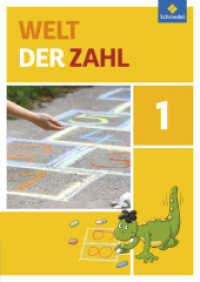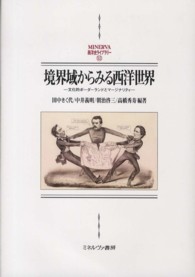- ホーム
- > 洋書
- > 英文書
- > History / World
Full Description
This book is the first to describe indigenous archaeology in Latin America for an English speaking audience. Eighteen chapters primarily by Latin American scholars describe relations between indigenous peoples and archaeology in the frame of national histories and examine the emergence of the native interest in their heritage. Relationships between archaeology and native communities are ambivalent: sometimes an escalating battleground, sometimes a promising site of intercultural encounters. The global trend of indigenous empowerment today has renewed interest in history, making it a tool of cultural meaning and political legitimacy. This book deals with the topic with a raw forthrightness not often demonstrated in writings about archaeology and indigenous peoples. Rather than being 'politically correct,' it attempts to transform rather than simply describe.
Contents
Introduction: What is to be done? Elements for a discussion. Cristobal Gnecco and Patricia Ayala.Entrance (exit): Archaeological knowledge and indigenous power. Alejandro Haber.Part I: When material culture matters: the State, indigenous peoples, and archaeologists1. Ruins and the State: archaeology of a Mexican symbiosis. Federico Navarrete.2. History and its discontents: stone statues, native histories, and archaeologists. Cristobal Gnecco and Carolina Hernandez.3. Indigenous archaeology in Peru? Alexander Herrera.4. Indiscreet spaces: repositioning the table of academia archaeology. Dante Angelo.5. Relationships with the indigenous other in the archaeology of Atacama. Patricia Ayala.6. Indigenous communities, archaeologists, and mining companies in northern Chile: towards a possible dialogue? Diego Salazar.7. Elements for a discussion about indigenous archaeological heritage and legal provisions: an archaeologist's perspective. Luis E. Cornejo.8. Archaeology and indigenous communities. A comparative study of legal provisions in Argentine and Brazil. Maria Luz Endere, Placido Cali, and Pedro Paulo Funari.9. Indigenous knowledge and archaeological science. Lesley Fordred Green, David Green, and Eduardo Neves.Part II: Indigenous archaeology, archaeology for indigenous peoples10. Reivindications of a Mesoamerican marginal group. The Otomies of the Valle del Mezquital. Fernando Lopez.11. Indigenous archaeologies or the struggle against the third transformation of Faustus: reflections from Colombian and Argentinean communities. Wilhelm Londono.12. Archaeology and identity: the Guambiano case. Luis Guillermo Vasco.13. The indigenous in the archaeological past: spectral reflections of postmodernism in Ecuador. Hugo Benavides.14. When tourists come . Communities and self-management of the archaeological heritage in Lipez, Bolivia. Francisco Gil.15. The message of the Kuviche in the Llew-Llew. Juana Paillalef Carinao.16. Archaeology and Amazonian caboclo groups: between regimes of historical transformation and the dilemmas of auto-representation. Denise Gomes.17. Archaeology and Paresi cultural heritage. Flavia Prado Moi and Walter Fagundes Morales.19. Declaration of Rio Cuarto.Exit (entrance): Archaeology, a part of the colonial chain? Marcelo Fernandez-Osco.Index







